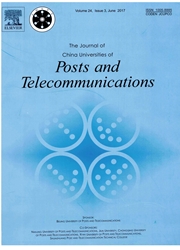

 中文摘要:
中文摘要:
提高的特征值分解(EEVD ) 基于隧道评价算法,它能解决飞行员污染问题在巨大多重输入、多重产量(巨大的 MIMO ) 隧道评价当在基础车站(NABT ) 的天线的数字趋于到无穷时,在这份报纸被建议。算法基于在快使系数矩阵褪色的接待飞行员信号和隧道的协变性矩阵之间的靠近的关系,即当 NABT 趋于到无穷时,后者是前者的特徵向量矩阵。因此,我们能在实际巨大的 MIMO 网络从样品协变性矩阵的特征值分解(EVD ) 得到一套规范的基础向量。由乘接待飞行员信号与结合规范的基础向量矩阵调换,隧道矩阵被投射到一个更低的维的矩阵,和 intra 房间,当 NABT 趋于到无穷时,内部房间的干扰能完全被消除。因此,我们仅仅需要在隧道评价期间估计更低的维的投射矩阵。当 signal-to-noise 比率(SNR ) 是 40 dB 时,模拟结果证明隧道评价的均方差(MSE ) 性能与约二个数量级被改进,与 EVD 相比基于的隧道评价算法。并且 signal-to-interference 比率(先生) 也极大地被改进。当 SNR 增加,先生的增长变得越来越大。
 英文摘要:
英文摘要:
The enhanced eigenvalue decomposition (EEVD) based channel estimation algorithm, which could solve the pilot contamination problem in massive multiple-input and multiple-output (Massive MIMO) channel estimation when the number of antennas at base stations (NABT) tends to infinity, is proposed in this paper. The algorithm is based on the close relationship between covariance matrix of received pilot signal and the channel fast fading coefficient matrix, i.e. the latter is the eigenvector matrix of the former when NABT tends to infinity. Therefore, we can get a set of normalized base vectors from the eigenvalue decomposition (EVD) of sample covariance matrix in practical Massive MIMO networks. By multiplying the received pilot signal with conjugate transpose of normalized base vector matrix, the channel matrix is projected to a lower dimensional matrix, and the intra-cell and inter-cell interference can be eliminated completely when NABT tends to infinity. Thus, we only need to estimate the lower dimensional projected matrix during the channel estimation. Simulation results show that the mean square error (MSE) performance of channel estimation is improved with approximately two orders of magnitude when the signal-to-noise ratio (SNR) is 40 dB, compared with EVD based channel estimation algorithm. And the signal-to-interference ratio (SIR) is improved greatly as well. The increment of SIR becomes larger and larger as SNR increasing.
 同期刊论文项目
同期刊论文项目
 同项目期刊论文
同项目期刊论文
 期刊信息
期刊信息
